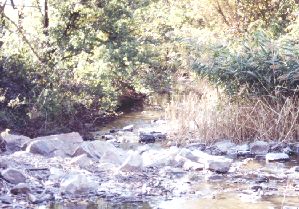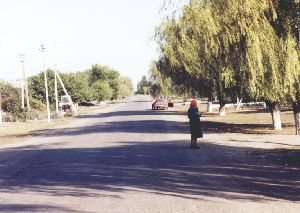 |
| Begim-Tschokrak River. Photograph by Ken Ratzlaff. See here. |
The land had previously been leased by Johann Cornies, Molotschna’s leading citizen, but he made it available for the new settlement and even gave the village its name. The original families who settled Waldhem had come from a wooded region in Volhynia, so Cornies combined the words for “forest” (Wald) and “home” (Heim) for the village name.
The original village was settled by forty families from the Volhynia region (see further here): eight in 1836, twelve in 1838, and twenty in 1840. If Loewen is correct that the first eight families included sixty-eight people (1992, 1, correcting Isaac 1908, 18), and if we can take that average family size of 8.5 people as generally representative, then after the first four years of its existence Waldheim had probably reached a population of approximately 340.
 |
| Main street on the north (landowners) half of the town. Photograph by Ken Ratzlaff. See here. |
Several decades later, around the turn of the century, Waldheim also became home to industry, as two farm equipment manufacturers and multiple steam mills and windmills were built. The factories not only provided jobs for the landless Mennonites within Waldheim but also attracted non-Mennonites in need of employment to the village.
According to William Schroeder and Helmut T. Huebert, Waldheim’s residents established their own separate church with their own elder (1996, 130). It is uncertain, however, when the first Waldheim church building was erected. Prior to that the group no doubt met in homes or possibly the school.
Nearly all Mennonites left or were removed from the village during the first half of the twentieth century, but the village still exists today, albeit with a different name: Vladovka 1 (the Mennonite village known as Hierschau, just to the east, is Vladovka 2).
 |
| Vladovka 1, the village known during the Mennonite period as Waldheim |
Although we may never know with certainty, it is extremely probable that not only David Buller but also Peter D lived in the village pictured above. We know David was living there in 1861. At sixteen years of age, Peter D presumably still lived at home at that time and did not move to Kleefeld until he married Sarah Siebert in 1866.
In fact, it is quite possible that Peter D was born in Waldheim. The village was established in 1836 and continued to be populated by immigrant families from Volhynia through 1840 (forty families in all), including at least one Zielke family: David Buller’s in-laws. It would not be surprising if David Buller moved to Waldheim when he wed Helena Zielke sometime around 1840. If so, then Peter D was no doubt born in Waldheim on 11 January 1845.
Beyond that, one wonders with which church the David Buller family associated. Did they meet with the other Volhynia Mennonites in Waldheim (first in homes or the school, later in a church building), or was the Alexanderwohl church 7 miles west (still) their church of record?
Other questions that await an answer include:
- From which Zielke family did Helena come?
- What did David do for a living in Waldheim?
- Where was Wirtschaft 48 (David’s 1869 farm) located?
- Was David buried in Waldheim cemetery? If so, is the cemetery still intact?
In time, perhaps we can find additional clues that at least point us in the direction of the true history of our Bullers in Molotschna.
Sources
Friesen, Rudy P., with Sergey Shmakin. 1996. Into the Past: Buildings of the Mennonite Commonwealth. Winnepeg: Raduga.
Isaac, Franz. 1908. Die Molotschnaer Mennoniten: Ein Beitrag zur Geschichte derselben. Halbstadt: Braun.
Loewen, Solomon L. 1992. Waldheim Village in Molochna Colony. Journal of the American Historical Society of Germans from Russia 15:1–14.
Schroeder, William, and Helmut T. Huebert. 1996. Mennonite Historical Atlas. 2nd ed. Winnipeg: Springfield.
No comments:
Post a Comment